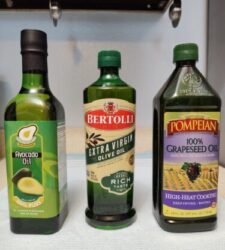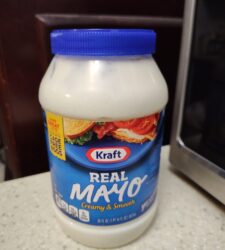There are Several Ways to Make Powdered Sugar
To make powdered sugar use cane sugar as the main ingredient. The ingredients label on the store-bought bag or container can imply it is made from sugar. In reality, if the label states “Cane Sugar”, it is made from sugar. When the label states the main ingredient is “Sugar”, it could be sugar made from beets or other GMO products. Wow, Sugar made from beets? How I see it is there needs to be better truth in labeling. What if someone is allergic or has an intolerance to beets? If I wanted powdered sugar beets, then I would buy them. Be careful to choose products that are non-GMO because a product that is GMO (Genetically modified, engineered, or bioengineered foods), is from organisms that have the DNA changed by genetic engineering methods. When you make your own you can control what is being added by choosing foods that are non-GMO. You will be healthier for doing so.
Affiliate Link
Ninja BN401 Nutri Pro Compact Personal Blender
Making Powdered Sugar Option 1
One way is to simply take 1 cup of raw sugar or regular white pure cane sugar and blend it in a blender for about 7 minutes until it resembles powder. Just be careful to wait a couple of minutes until the cloud of powdered sugar has settled in the container before you take the lid off. You don’t want to get “Bakers Lung”. It is best to stop the blender after each 1 ½ minute segment of time and wait for the sugar cloud to dissipate. Then remove the lid and use a small spatula to scrape the sugar off the sides of the blender. After it sufficiently resembles powdered sugar, then store it in an air and moisture-tight container.
Making Powdered Sugar Option 2
Another way is to make it with Cane Sugar and Cornstarch. Cornstarch is an anti-caking agent. This means it can absorb moisture and help to prevent clumping. You could also use Potato Starch or Tapioca Flour as a thickening agent. I have never used Potato Starch and Tapioca Flour myself in this process, so I don’t know if you need additional time in blending. Most of the powdered sugars on the market have cornstarch or potato starch as one of the ingredients. Real cane sugar has a slightly yellowish-light brown color. Once it is sufficiently blended into powdered sugar the color is white.
Ingredient Ratio and Other Facts About Powdered Sugar
1 cup of Raw Sugar Cane to 1 tablespoon of Cornstarch. Simply blend the sugar until it resembles powdered sugar and then add the cornstarch at the end. Note: This process usually takes about 7 minutes of blending time. After each 1 ½ minute segment of time let the powdered sugar cloud dissipate before removing the lid and use a spoon or small spatula to loosen the sugar from the sides of the container. When you are ready to store it can be stored in a mason Jar or zip-lock baggie. If you have a Vacuum sealing machine that would be good too.
How to Make Light Brown Sugar
To make Brown sugar you can use molasses, honey, or agave syrup along with the Cane Sugar.
The ratio for Light Brown sugar is 1 cup of “Cane Sugar to 1 tablespoon of molasses, if you like dark brown sugar, then add an additional 1 or 2 teaspoons more of the molasses.
Combine both ingredients in a mixing bowl. Blend in the molasses using a hand mixer on a low setting. You are done once it has no lumps and a smooth granular consistency. Then store it in an airtight or moisture-free container or use a vacuum seal machine to seal it in a bag.
Note: In lieu of molasses then you can use maple syrup, agave nectar, or even honey to make the brown sugar. Molasses is made from Cane sugar or beet sugar. Maple syrup is made using maple tree sap.
Sorbitol Warning
Diet maple syrup can have Sorbitol sweetener in it. This is a sugar alcohol. Consuming excess sugar alcohol can cause side effects like gastrointestinal discomfort, gas, bloating, diarrhea, abdominal cramps, high blood sugar (hyperglycemia), dry mouth, swelling (edema) nausea, and vomiting. Consuming as little as 20 grams of Sorbitol can cause diarrhea because it is absorbed slowly in the small intestine. Be careful of using diet maple syrup, sometimes manufacturers put other artificial sweeteners or preservatives in them too.
The FDA also has a warning in association with Sorbitol. It is as follows: Daily ingestion of 50 grams of sorbitol shall bear the statement: “Excess consumption may have a laxative effect.” If you are using diet maple syrup, purchase the kind that is 100% maple syrup to avoid this additive. It is my opinion that if it takes as little as 20 grams to cause all those side effects, then how much worse are the effects having 50 grams? Something to think about!
Avoid Brown Sugar Contamination
Brown Sugar can get mold if moisture or other contaminants enter the container. If you don’t see the mold but there is a strange odor, then that can be a precursor to mold. If this happens you will need to throw it in the trash.
Please note that it can get a little compacted or hard if you don’t use Brown Sugar for a while. It is still good, just blend it with a whisk or fork for a quick minute and it will return to that nice granular consistency you are used to.
Does Raw Sugar Have Molasses in it?
Molasses is derived from the liquid in sugar cane. This is extracted in a process. In order to get the liquid needed from the sugar cane it is crushed and then the juice is extracted. This liquid is then boiled until sugar crystals form. At this point, the sugar crystals are removed. The brown syrup left is the molasses.
Raw sugars contain some of the original molasses left over from refining. Brown sugar is raw sugar with molasses added back after the refining process. By doing this the raw sugar will darken to become the recognizable brown sugar and flavor we are happily used to.
Un-refined Brown Sugar
Un-refined sweeteners retain most of the original cane molasses. Some un-refined brown sugars are muscovado, panela, jaggery, and piloncillo.
Muscovado sugar is a form of sugar that is all-natural. It is made by evaporating the liquid from the cane juice without removing the molasses. India is the top producer of muscovado. Other countries that produce Muscovado are Colombia and the West Indies. Because Muscovado is a “raw sugar”, the molasses has not been removed. The ingredients will be labeled as Cane Sugar.
Panela sugar is produced in Latin America and some parts of the Caribbean including Colombia. There is actually a National Panela Pageant in the town of Villeta, Cundinamarca Columbia. It has been hand-made for centuries by dehydrating raw sugarcane juice over low heat. This allows the molasses to retain a lot of its nutrients and flavor from the sugarcane. Because it is all-natural the Panela sugar will retain some vitamins. (Vitamin, A, B, C, D, and E). Panela sugar can help strengthen your immune system and vision. This is anti-inflammatory and anticarcinogenic. Finally, sugar that’s good for you!
Jaggery sugar is a product of Asia and Africa. They can make it from palm trees (types: coconut, date, sago, or toddy palms) or sugarcane juices. It also has some vitamins and is healthier than white sugar. On labels it can be listed as unrefined sugar or as in the case of India they call it “Gur”. To process it they boil the juice to reduce it to a crystalline syrup. Then it is poured into molds to harden. When needed you simply mix or scrape it to get granules.
Piloncillo is from Mexico. They have been making it for centuries. This brown unrefined whole cane sugar has an earthy taste of caramel. It comes in molasses or brown sugar. You can find it in Mexican markets pressed into loaves or blocks, and cones. Because of the minimal processing, Piloncillo retains some of its vitamins and minerals. (Iron and magnesium)
Even though all these sugars have a slightly healthier nutrient value it is essential to eat it in moderation.


